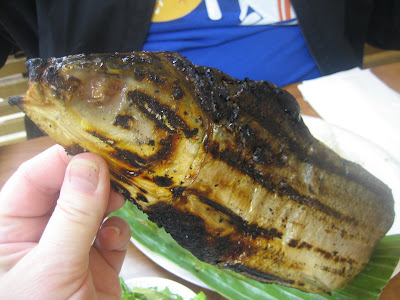The centerpiece of that meal was moqueca, a seafood stew popular along the country's coastline, one that reminded me of quite similar seafood stews from other parts of the world, including caldeirada, which is what the Portuguese call their moqueca. But there's a lot more to Brazilian food than the coastline, for Brazil is a huge country, the largest in South America--and the fifth largest on the planet. We ventured to Tropicalia Brazilian Grill in Los Feliz to discover what lies inland.
First we paused to tip our hats to the sea with an order of ceviche. This combo of white fish and shrimp was "cooked" in lemon and lime juices and tamed with a splash of oil. It came on a bed of tortilla chips with pico di gallo and "Brazilian guacamole." I asked our server what made it specifically Brazilian, since it tasted like plain ol' guac to me. She admitted that the only thing Brazilian about it was the name, adding that that was true of the Brazilian tiramisu as well. That was going to be my next question, so she saved me having to ask.
Oh well, time to move beyond surf to turf. I ordered Bife Tropicalia, a marinated and grilled steak, served with black beans, rice, plantains, farofa and salsa campanha, which appears to be a house special. The thin steak was flavorful and moist all on its own and even better with a shmear of cilantro sauce. To the left of the steak in the photo is farofa, which is popular in the region of Minas Gerais. It's a sort of coarsely ground, toasted yucca flour. You sprinkle it over and mix it into your food to give it a little crunch and a pleasantly toasty flavor. In fact, everything I stirred it into and sprinkled it over tasted better with it than without it. It was a nice surprise.
I'll have to rummage about in the international food markets around town and try to find some yucca flour to experiment with--it's also known as manioc and cassava--gotta keep that in mind while reading labels. Different cooks all have their own ways of preparing it, involving different spices and cooking it in either butter or bacon fat. I'm sure it will be good in dishes other that specifically Brazilian ones, too. This is going to be some tasty experimentation.
Himself got half a chicken, grilled, topped with tomato malagueta and cilantro sauce. His meal was also served with farofa. The malagueta chiles used in the sauce give it a medium-hot kick, so that you get a pleasant amount of heat while tasting the sauce itself. When there's so much heat in a sauce that it obscures the flavor, it reaches into the "what's the point?" range of hot on my own personal Scoville meter. This malagueta sauce was just right. (I'm sure Goldilocks would approve.)
The one dish I'd been reading about that is regarded as the essence of the Brazilian table, feijoada, is served here only on Thursdays and Fridays, so I'll have to return for it. It's Brazilian by the way of Portugal...or would that be Portuguese by way of Brazil? Anyway, it's a bean stew containing both pork and beef, and the Portuguese brought it with them when they settled here.
Since none of the desserts on the menu were specifically Brazilian, I decided to try my hand at making a more authentic sweet. I selected creme de abacate--avocado cream--because it's simple and tasty, and because it does something most North Americans don't think about doing with an avocado. I've had avocado shakes at my favorite Vietnamese restaurant back home in Memphis, so I know avocado works beautifully in sweet as well as salty applications.
Into a blender or small food processor place the flesh of one large avocado, a tablespoon of fresh lime juice and a tablespoon of sugar, and give 'em a whirl, until you have a smooth, sweet pudding. Adjust to taste, adding more lime juice or sugar--or both--as you like. Chill it well before eating--the citrus prevents it from oxidizing, so don't worry about it turning dark while it sits in the fridge. Next time I think I'll try topping it with a bit of crème fraîche to cut the richness.
As with every cuisine I've sampled in the past few months, I know I've not even scratched the surface of this one. Brazil's population isn't just the locals with a few Portuguese thrown in. Wave upon wave of immigrants have brought to the mix influences from places as disparate as Italy, Poland, Lebanon and Japan. It will be fun to explore how these varied cultures have influenced Brazilian cuisine.














































